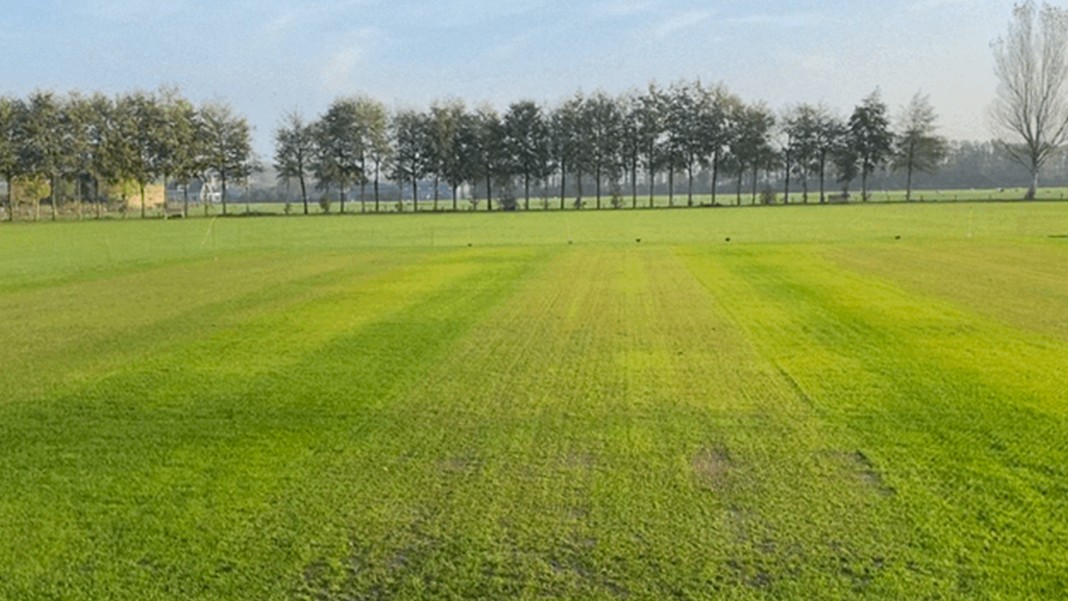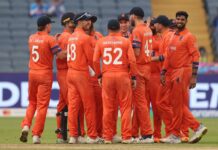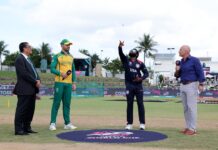Leading Topklasse club Voorburg literally broke new ground in Dutch cricket last week with the installation of five hybrid pitches at its Westvliet complex.
The technique, which involves stitching polyethylene yarn onto the natural grass, produces pitches which comprise 95% natural grass and 5% artificial, and was first developed in the Netherlands to create longer-lasting football pitches.
Although it has since been adopted for a range of cricket grounds in England, including the ECB’s National Performance Centre in Loughborough, Nottinghamshire’s Trent Bridge, and practice pitches at Lord’s, the Oval and other Test venues, this is the first time it has been used at a Dutch ground.
Westvliet is one of seven grounds in the Netherlands which possesses a turf square, and one of the five which have been granted ODI status.
Speaking to Emerging Cricket on Saturday, project manager and Voorburg’s head coach Tom de Grooth, who played 132 times for the Netherlands between 2003 and 2015 and who was Player of the Match in his country’s historic victory over England at Lord’s in the 2009 World T20 tournament, said that with seven pitches in its square the club had found it impossible to achieve its goal of allowing all teams to gain the experience of playing regularly on grass.
‘We have even had to turn down some requests from the KNCB to host youth matches because of the level of demand on the square and the long preparation and recovery times,’ he added.
The club had considered increasing the width of the square, but had ultimately rejected that for the time being in favour of turning to the hybrid grass technology for five of the seven strips.
‘The strips wear more slowly and can therefore be used for more matches,’ De Grooth points out, ‘and it reduces preparation times for each pitch and cuts the renovation time from six or seven weeks to four or five, meaning that you can rotate the strips quicker and thus get more games.
‘You still have to prepare pitches as usual, but they last longer and recover quicker.’
De Grooth and his colleagues were prevented by the pandemic from travelling to England to see hybrid pitches in action there, but he has consulted extensively with several English groundsmen, including Malcolm Pooley, who originally laid the Westvliet square in 2009, Essex head groundsman Stuart Kerrison, and Warwickshire head groundsman Steve Rouse.
The club also received feedback from allrounder Logan van Beek, who played for Derbyshire in the Vitality Blast last season.

Hybrid pitches have already been approved by the ECB for its One Day Cup, the Vitality Blast and all formats of second eleven cricket.
‘They’re not yet accepted for men’s ODIs,’ De Grooth notes, ‘but since you can play T20 Internationals on artificial mats it seems likely that there won’t be a problem with hybrid grass surfaces.’
The new pitches have been installed by SIS Pitches, the Dutch company which developed the technique and which has been laying pitches in England. The cost of putting in the five hybrid strips has been €25k.
‘The only big difference from natural grass is that the hybrid pitches dry out quicker and therefore need more water,’ De Grooth says. ‘Otherwise there’s no difference in the preparation, except that you only need eight days.
‘We will take the grass down to five mm. at the start of the season, which is about the same as we would normally do.’
Asked how he expects Voorburg’s new surfaces to play, De Grooth points out that turf pitches in the Netherlands tend to be slow and low.
‘You still need to produce good pitches with this new technology,’ he says with a smile, ‘but we wouldn’t mind if we were able to get some extra pace and bounce.’
Given that one of Voorburg’s strengths is a pace attack which includes Dutch internationals Van Beek, Viv Kingma and Bas de Leede, this could make a visit to Westvliet interesting for opposing batters in the Topklasse next season.
‘Our club has made a leap of faith,’ says chairman Kobus Nel. ‘We reckon we have some of the best pitches in the country, and it’s always a risk trying to make something that works well even better.
‘But there has already been a lot of interest from other clubs with turf squares, and the KNCB has been keen on the project from the outset. We believe that it will help to improve the quality of Dutch cricket.’
The hybrid pitches are not the only major development at Westvliet this autumn: the club is also replacing its outdoor nets with a four-lane indoor facility, enabling its players to train throughout the year.
The sides will be removable during the summer, converting the nets into a semi-outdoor facility.
The new Westvliet nets, two lanes of which are being extended to 50m., will be the fifth indoor centre in the country, following VOC’s in Rotterdam, the new VRA facility in Amstelveen, Kampong’s covered nets in Utrecht, and an all-purpose hall in Schiedam.
With this range of options, running winter training sessions for national men’s, women’s, boys’ and girls’ squads will become much easier, as well as encouraging club players to work on their game during the off-season.
You’re reading Emerging Cricket — brought to you by a passionate group of volunteers with a vision for cricket to be a truly global sport, and a mission to inspire passion to grow the game.
Be sure to check out our homepage for all the latest news, please subscribe for regular updates, and follow EC on Twitter, Facebook, LinkedIn and YouTube.
Don’t know where to start? Check out our features list, country profiles, and subscribe to our podcast.
Support us from US$2 a month — and get exclusive benefits, by becoming an EC Patron.







